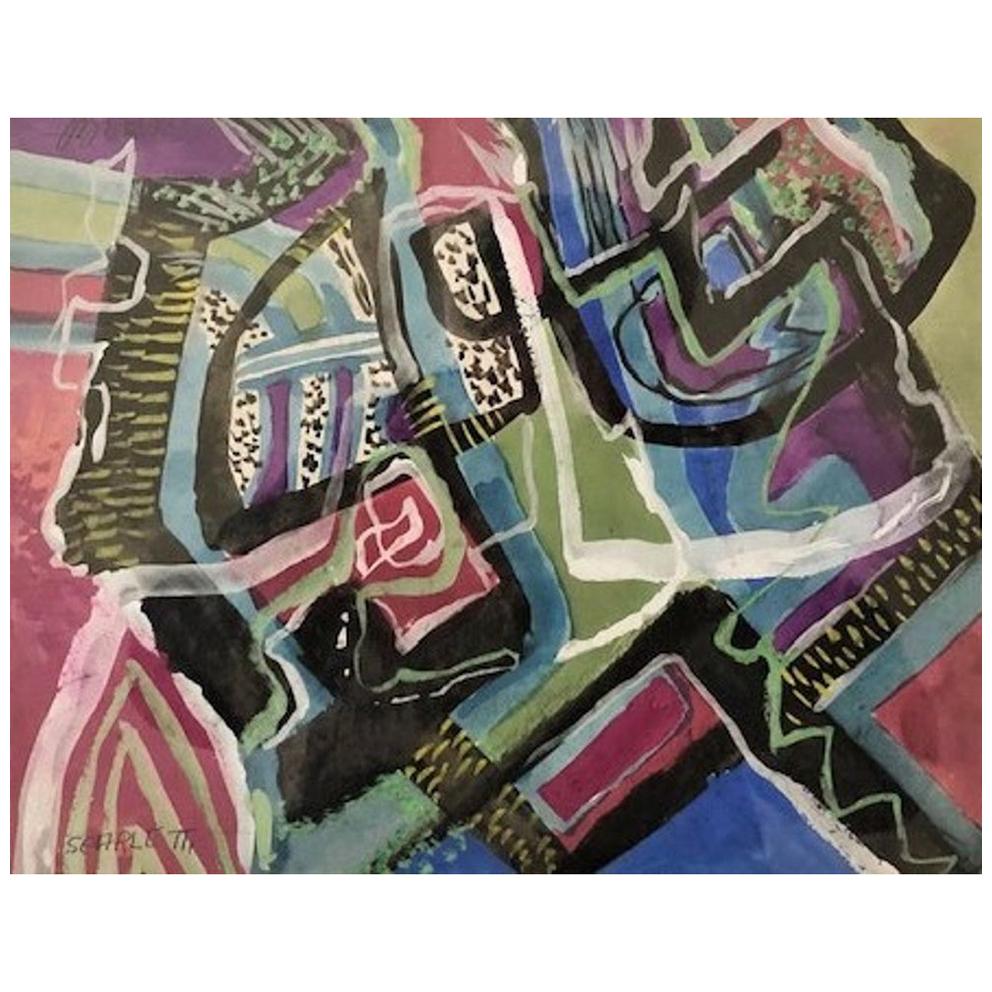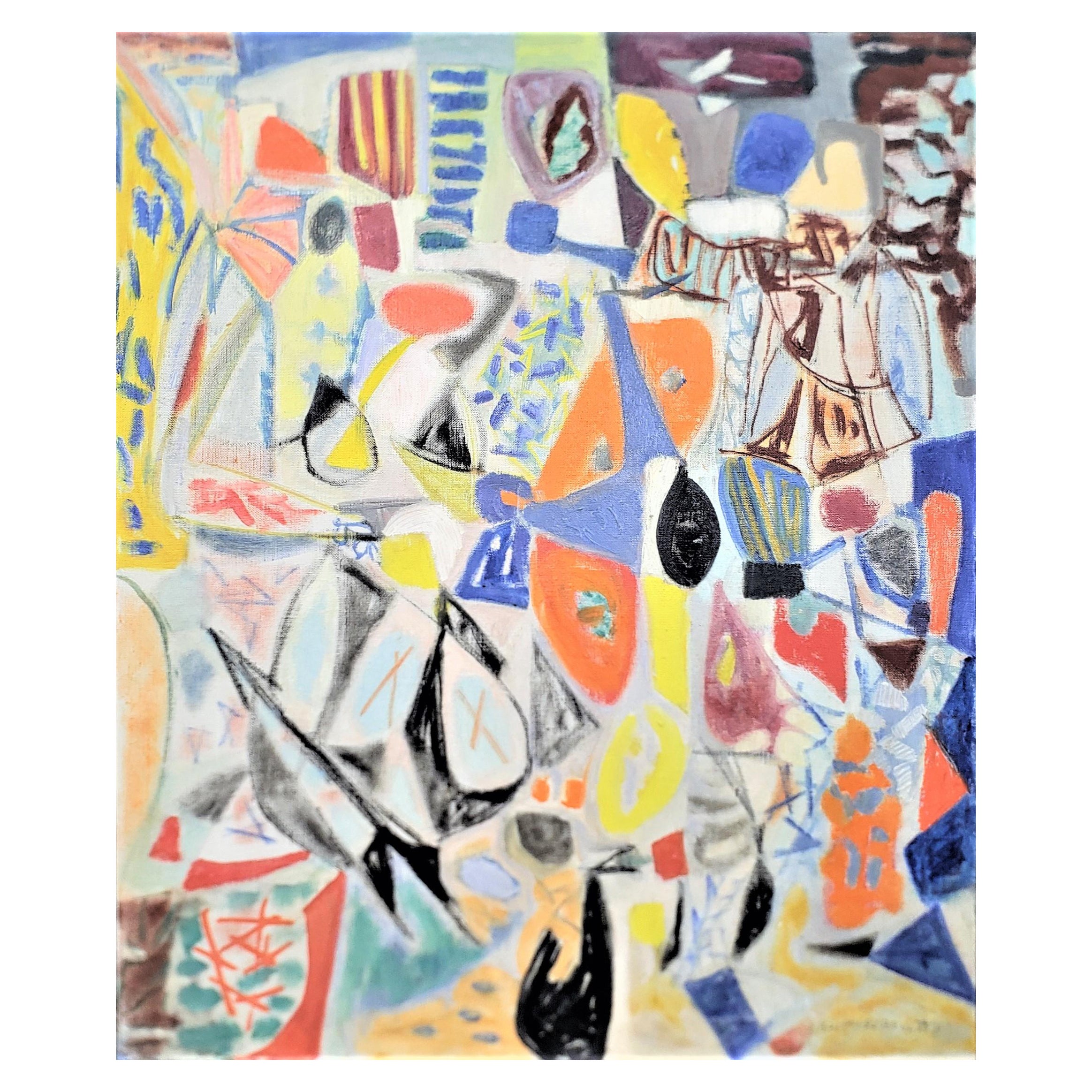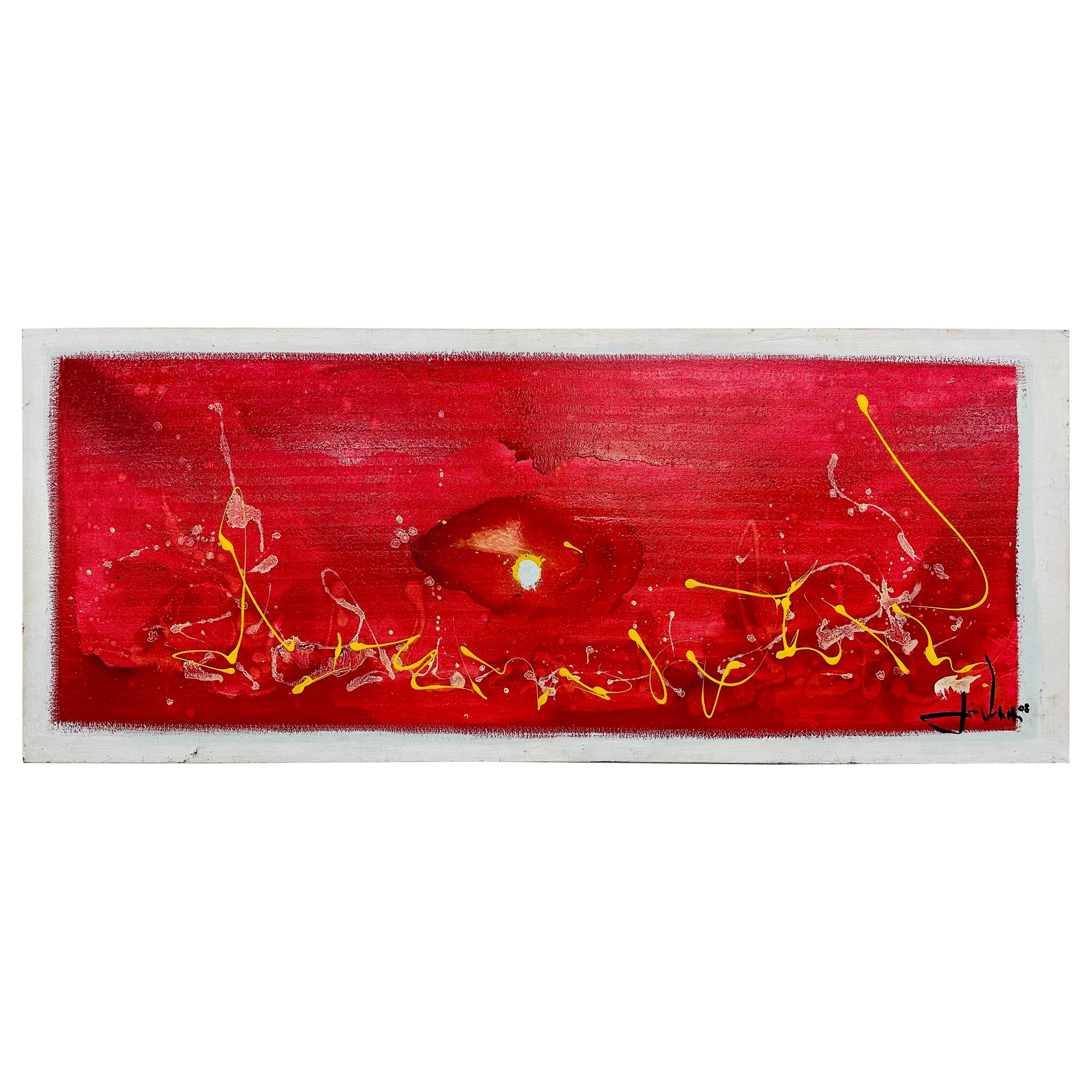Items Similar to Rolph Scarlett Abstract Expressionist Painting, 1945
Want more images or videos?
Request additional images or videos from the seller
1 of 6
Rolph Scarlett Abstract Expressionist Painting, 1945
About the Item
Abstract expressionist gouache and watercolor on paper
by noted artist Rolph Scarlett - Signed and dated lower right.
Archivally matted, unframed. Image size: 11" H x 15" W.
In excellent condition.
Rolph Scarlett was a painter of geometric abstraction during the American avant-garde movement of the 1930s and 1940s.
Born in Guelph, Ontario, Canada in 1889, he left Canada at the age of 18 to go to New York City and returned to Canada during the years of World War I. However, by 1924 he had established New York City as his home. While he was beginning his career as an abstract painter, he was designing stage scenery for George Bernard Shaw's play, Man and Superman and for the Rockettes at Radio City Music Hall.
In 1939, while in the process of creating the Museum of Non-Objective Painting (later the Solomon R. Guggenheim Museum), Director Hilla Rebay began to take an interest in Scarlett's work. By 1940 he had become the new museum's chief lecturer.
By 1953, the Guggenheim owned nearly 60 of his paintings and monoprints. He later became a resident of the Woodstock art colony for more than twenty-five years and showed his work in the Woodstock exhibits.
Bio Source: Peter Hastings Falk.
- Creator:Rolph Scarlett (Artist)
- Dimensions:Height: 16 in (40.64 cm)Width: 20 in (50.8 cm)Depth: 0.5 in (1.27 cm)
- Style:Mid-Century Modern (Of the Period)
- Materials and Techniques:
- Place of Origin:
- Period:
- Date of Manufacture:1945
- Condition:
- Seller Location:Phoenix, AZ
- Reference Number:
About the Seller
5.0
Gold Seller
These expertly vetted sellers are highly rated and consistently exceed customer expectations.
Established in 1988
1stDibs seller since 2016
323 sales on 1stDibs
Typical response time: 2 hours
- ShippingRetrieving quote...Ships From: Phoenix, AZ
- Return PolicyA return for this item may be initiated within 14 days of delivery.
More From This SellerView All
- Rolph Scarlett Original Watercolor Dated 1952, Geometric AbstractionBy Rolph ScarlettLocated in Phoenix, AZAbstract watercolor by Rolph Scarlett, signed lower left. A great example by Scarlett. Measures: 19" H x 21" W image size. New modernist custom-made frame. Size: 24 1/4" H x 26 3/4" W. Rolph Scarlett was a painter of geometric abstraction during the American avant-garde movement of the 1930s and 1940s. Born in Guelph, Ontario, Canada in 1889, he left Canada at the age of 18 to go to New York City and returned to Canada during the years of World War I. However, by 1924 he had established New York City as his home. While he was beginning his career as an abstract painter, he was designing stage scenery for George Bernard Shaw...Category
Mid-20th Century American Mid-Century Modern Paintings
MaterialsPaper
- Harold Christopher Davies Abstract Expressionist Painting, circa 1960sBy Harold Christopher DaviesLocated in Phoenix, AZHarold Christopher Davies (1891-1976) abstract painting. Signed lower right, circa 1960s Measures: 18 1/4" H x 8 3/4" W Oil on paper, unframed Davies began his formal art educa...Category
Mid-20th Century Paintings
MaterialsPaint
- Harry Crowley NYC Abstract Expressionist Painting, circa 1954, Slow SolitudeBy Harry CrowleyLocated in Phoenix, AZHarry Crowley (1898-1979) oil on board, 1954. Abstract Expressionist. Titled on the verso “Slow Solitude.” Measures: 33 x 38. Frame: 42 x 47. In excellent condition and in the original frame. Beautiful abstract design in greens, browns and blues. Signed lower left. Signed & titled on the verso. Has a Harry Salpeter Gallery, 42 W 57th Street, N.Y. label on the back. Crowley was a musician and artist in Hollywood who moved east and became involved with the New York theater...Category
Vintage 1950s Paintings
MaterialsPaint
- Renee Harcombe Florida Painting, Circa 1945, Pink ParrotsLocated in Phoenix, AZRenee Harcombe Female Florida Artist 20th century - oil on canvas. Features a beautiful pair of pink parrots. Circa 1945. In excellent condition. Mea...Category
Mid-20th Century Paintings
MaterialsPaint
- Harold Christopher Davies Abstract Expressionist Oil on Paper, 1968By Harold Christopher DaviesLocated in Phoenix, AZHarold Christopher Davies (1891-1976) abstract painting. Signed lower left Rubber stamp on the back from Hoover Gallery, San Francisco Initialed and dated on the back, 1968 Oil o...Category
Mid-20th Century Paintings
MaterialsPaint
- H. Wilson Smith California Artist Abstract Painting, circa 1940s-1950sBy H. Wilson SmithLocated in Phoenix, AZH. Wilson Smith (1901-1981) California Artist Oil on board in the original frame. Painting measures 31 3/4" H x 27 3/4" W Frame 22 3/4" H x 28 3/4" W. Signed lower right “H. Wils...Category
Mid-20th Century Paintings
MaterialsPaint
You May Also Like
- Rolph Scarlett, Modernist Abstract Composition, Guache on Paper, Ca. 1950’sBy Rolph ScarlettLocated in New York, NYArtist: Rolph Scarletti (Canadian, 1889 – 1984) Object: Modernist Abstract Composition Period: Ca. 1950’s Medium: Guache on paper, framed Dimensions (unframed): Height: 9-1/3” Width: 12” Dimensions (framed): Height: 22-3/4”” Width: 25-3/4” Rolph Scarlett (Canadian, 1889 – 1984) was a consummate explorer of twentieth-century abstract painting. Never afraid of trying new styles, curious and opinionated, constantly engaged with the world around him while steadfastly aware that he was on his own path and his alone, Scarlett more than once proved to be at the artistic zeitgeist of the eras in which he lived. Exposed very early on to the work of Paul Klee through a chance meeting in Europe with the artist himself, Scarlett took up abstraction with a fervor that never diminished during his long and impressive career. To create something that had never existed before: this was Scarlett’s great cause. And that is what is most obvious when you look at Scarlett’s work—you have never seen anything quite like it. Scarlett was Canadian-born, came of age in the Midwest, and spent few important years in Hollywood, where he designed stage sets. His work from this early period echoes Klee’s use of color, his confidence in naïve, primitive forms, and his blend of abstraction and figuration. In its flat spatial qualities it prefigures the Indian Space painting of the 1940s by a decade. He moved to New York in 1933 and eventually found his first great patron at the Museum of Non-Objective Painting, directed by Baroness Hilla Rebay and art patron Solomon R. Guggenheim. Guggenheim would collect over 60 works by Scarlett for his collection, more than any other artist outside of Vasily Kandinsky and Rudolf Bauer. As a frequent exhibitor and lecturer at the Museum of Non-Objective Painting (MNOP), Scarlett honed his sensitive feel for bodies in space and capitalized on his trademark use of bright, vivacious colors into accomplished, perfectly harmonized geometric works. However, Scarlett soon morphed these hard-edged forms into a nuanced expressionistic abstraction which, at its best, seems to be populated by dancing forms that animate the canvases. Along this way he was advised by Rudolf Bauer, the German expatriate and one of the originators of non-objective painting in the teens. Bauer had the idea for the Museum, and Rebay, his champion, had found in Solomon Guggenheim a patron for manifesting it. When Bauer emigrated just before World War II, he wanted to meet Scarlett. The two became friends, and Bauer advised Scarlett on his work over the course of many years. Even in a 1979 interview, Scarlett began to tear up as he recalled his first meeting with Bauer, a man whose work he "worshipped," describing that, "It was a touching moment for me, I’ll tell you." Scarlett and Rebay also had a close, important relationship, one in which he bore the brunt of her sometimes condescending, if motherly, critiques and admonitions with tolerance and gratefulness. Eventually, though, he had to push back. In a letter from 1951 he writes, "I have noticed with growing amazement that during the past three years you have accepted less and less of my work—and, that same work, which you rejected has been accepted and shown in the best and largest shows all over this country." This period—the late 1940s to the early 1950s—did in fact correspond to Scarlett’s most critical success, and to a return to the fanciful forms and characters of his pre-war work. At the same time, he found his own rhythm and complexity using a drip style similar to, though denser and more opaque than, the one made famous by Jackson Pollock, who had worked for many years at the MNOP and with whom he shared common influences. In 1949 he had a very well received solo show in 1949 at the Jacques Seligmann Gallery, reviewed very favorably in The New York Times: "The impression made by these paintings is one of originality and strength." He was also included in a juried show "American Painting Today" at the Metropolitan Museum of Art in 1950 and in the Whitney Annual of 1951. The curator for the Whitney show in fact bypassed a selection of Scarlett’s careful geometrics in favor of a new "lyrical" drip painting—one which he describes as having had "a helluva good time" making. Rebay articulated her loss of control over Scarlett very keenly in one of her last official letters to him: "So your way ended in the horrid jungle it is in now; even a Mr. Pollock’s smearage was not bad enough for you to have a try at; and betraying yourself, you betrayed art and my faith in you, and my present disgrace by my failure to foresee such an outrageous possibility—since you even paint objectively now." Yet, despite the fact that he was moving in his own direction when the change in leadership took place at the Museum of Non-Objective Painting and Rebay was forced out as director, Scarlett was hit hard. He understood this change rightly as a betrayal by the establishment. Scarlett was a unique individual and soul, and was affected personally and philosophically by the idea that the movement with which Scarlett had aligned his talents seemed to disappear overnight, and his life’s work rendered valueless. Without the Museum’s support, Scarlett decided eventually to move to the artists’ community of Shady, New York, just outside of Woodstock. He had occasional shows throughout the years, but mostly settled down to regional obscurity. He began making jewelry, which had been his first trade, and it was following a show of his jewelry in 1975 at the Jaro Gallery, that he was rediscovered by Samuel Esses, and his wife Sandy. Samuel Esses was a successful businessman and an avid collector. He always sought out that which was unusual and, like Scarlett, was ahead of his time in many ways. For example, in 1979, Sam became enthralled with the early graffiti appearing on the New York subway trains. With the sole goal of preserving these groundbreaking yet short lived works of art he was inspired to create "The Esses Studio," a painting warehouse and workshop for graffiti artists to work in a studio, collaborate, and paint on canvas. The biggest names of graffiti writing participated—Futura, Crash, Dondi, Zephyr, and Daze to name a few. The project was well received and provided critical validation at an important time for this alternative form of abstraction to be recognized by the established art world. The success of the "Esses Studio" helped fuel an alternative fire that would propel gallerists and curators to acknowledge other street artists and provide a foundation of acceptance for the early careers of Keith Haring and Jean-Michel Basquiat. It is not a stretch to say that what Esses saw in the graffiti art of the 1970s was very similar to what he saw in 1950s-era Scarletts—something raw, honest, and melding many twentieth century influences into one unique form. Inspired by the importance of the collection and the passion of the collector, Weinstein Gallery...Category
Vintage 1950s Canadian Mid-Century Modern Paintings
MaterialsPaper
- Rolph Scarlett Original Non-Objective Modernist Oil Painting on Canvas: UntitledBy Rolph ScarlettLocated in Hamilton, OntarioThis original painting was done by the well known Canadian-American Rolph Scarlett, dating to approximately 1950 and done in his Non-Objective Modern style. This abstract painting is...Category
Mid-20th Century Canadian Mid-Century Modern Paintings
MaterialsCanvas, Pine
- Abstract Expressionist PaintingLocated in Santa Barbara, CAContemporary abstract expressionist painting signed "Daddino", unframed on stretched canvas. In good condition with no major issues to note.Category
Late 20th Century Mid-Century Modern Paintings
MaterialsAcrylic
- Modern Abstract Expressionist PaintingLocated in Clarksboro, NJThis listing is for a Modern Abstract Expressionist Painting. Featuring a rectangular canvas, a mixture of red, white, and yellow colors, and signed on the bottom right.Category
Early 2000s American Mid-Century Modern Paintings
MaterialsPaint
- Large Scale Abstract Expressionist PaintingLocated in Atlanta, GALarge scale abstract expressionist painting, American, circa 1980s. Artist unknown, in the manner of Franz Kline, et al. I...Category
Vintage 1980s American Mid-Century Modern Paintings
MaterialsCanvas, Paint
- Yamil O Cardenas Abstract Expressionist PaintingBy Yamil O. CardenasLocated in Miami, FLYamil O Cardenas abstract expressionist painting in acrylic on canvas. Yamil O Cardenas was born in Cuba in 1972 and recently moved to Miami in the USA. Growing up he was attracted...Category
2010s American Modern Paintings
MaterialsCanvas, Acrylic, Wood
Recently Viewed
View AllMore Ways To Browse
Vintage World Radio
Radio City Music
Radio 1940
George Shaw
Vintage Scarlett
Mid Century Vintage Ontario
Scarlett Rolph
Vintage Home Radio
Canadian Vintage Radio
George Bernard Shaw
Peter Shaw
Vintage Rockettes
19th Century Marquetry Chest
Painted Green Chest
Antique Commode With Bronze
Double Door Italy
Small Painted Chest Of Drawers
Small Vintage Chest





